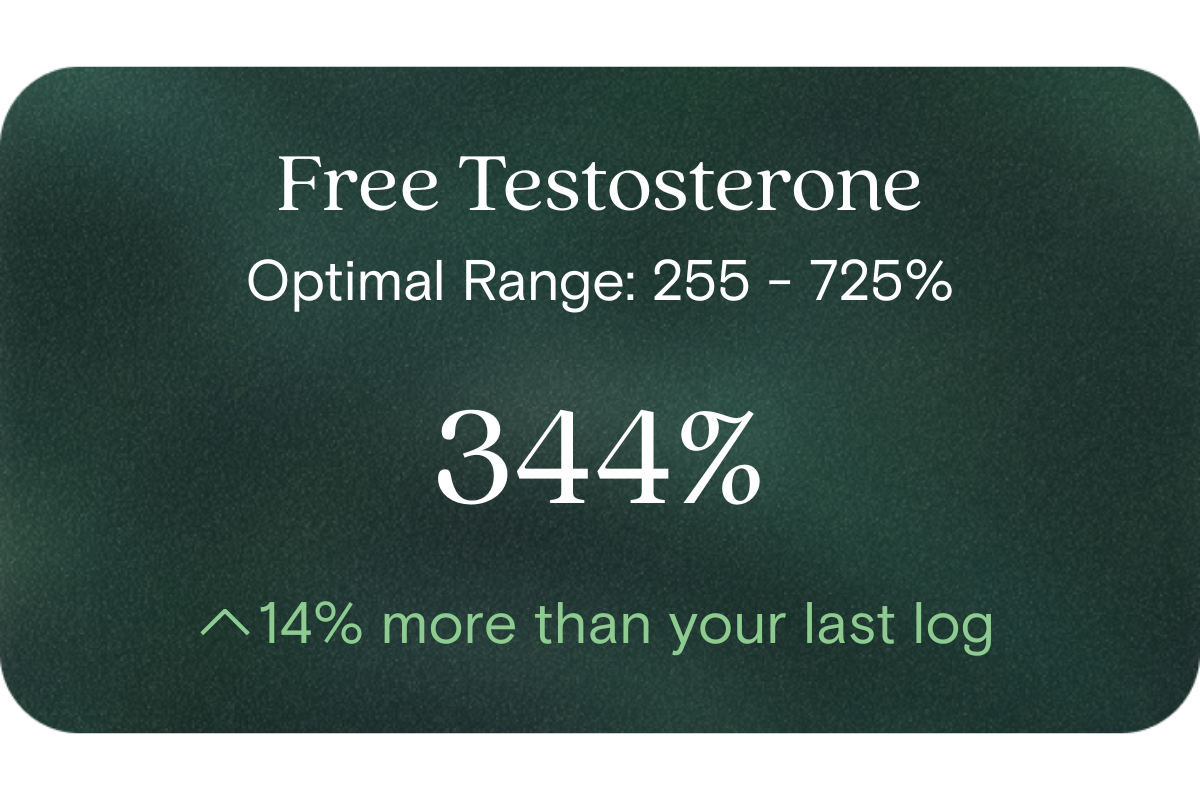What is Free Testosterone?
Free testosterone is the fraction of testosterone in your bloodstream that is not bound to carrier proteins (primarily SHBG and albumin). Because it is unbound, it is immediately bioavailable to tissues and thus considered a more accurate indicator of androgenic activity than total testosterone alone.
Why does it matter for long-term health and wellbeing?
Free testosterone influences muscle strength, lean mass, metabolic rate, fat distribution, mood, libido and energy. Over the long term, maintaining a healthy free testosterone level can support better recovery, metabolic resilience, and preserve functional capacity as you age. Deviations from the optimal range provide early signals for lifestyle adjustment before downstream negative effects accumulate.
What’s an optimal level of Free Testosterone?
- Laboratory (reference) range (Australian typical): ~ 260 to 740 pmol/L in adult males (based on the Alfred Pathology handbook)
- Some sources suggest that values down to ~ 140 pmol/L may be observed with age, though this is outside the young-healthy reference window
- In research using equilibrium dialysis, normative ranges in healthy, non-obese men are ~ 229 to 1,070 pmol/L (2.5th to 97.5th percentile)
- Optimal targets may sit comfortably in the upper half of the reference zone (e.g. ~ 400–700 pmol/L in younger men), but optimal ranges should always be interpreted in the context of age, symptoms, SHBG, and individual goals.
What influences Free Testosterone levels?
Free testosterone is shaped by production (gonadal function), clearance, and binding dynamics (primarily SHBG levels). Key modulators include:
- Age: free testosterone declines with age, partly via increases in SHBG.
- Body composition (BMI, adiposity): higher BMI and adiposity tend to lower free testosterone, especially beyond a threshold.
- Lifestyle factors: physical activity, quality sleep, dietary fat intake, alcohol use, stress and insulin sensitivity all have impacts on testosterone and SHBG.
- SHBG alterations: anything that raises SHBG (e.g. thyroid shifts, certain hormonal states) reduces free fraction; anything lowering SHBG (e.g. obesity, insulin resistance) may mask a drop in free testosterone even if total remains “normal.”
What does it mean if Free Testosterone is outside the optimal range?
- If free testosterone is below the optimal (or reference) range: this suggests there may be insufficient androgenic drive at the tissue level. You might experience decreased energy, difficulty building or maintaining muscle, shifts in fat mass, or declines in motivation or libido.
- If it is above the optimal range: it may indicate androgen excess, possibly leading to adverse effects like acne, accelerated hair thinning, or undesired hormonal strain.
- Importantly: a value outside your lab’s reference or your own optimal zone is a signal for lifestyle review, not a diagnosis. It invites adjustments — earlier, more precise, and personalised interventions.
How can I support healthy Free Testosterone levels?
You can influence free testosterone through lifestyle choices:
- Strength training and resistance exercise: stimulate androgenic responses and preserve lean mass.
- Maintain lean body composition: reducing excess adiposity, especially visceral fat helps minimise hormonal suppression.
- Adequate dietary energy and healthy fats: extremely low-fat diets may reduce testosterone.
- Optimal sleep and circadian health: poor sleep or shift patterns can blunt testosterone rhythms.
- Stress management and insulin sensitivity: chronic stress and insulin resistance increase SHBG perturbations and metabolic interference.
- Avoid excess alcohol, smoking, or endocrine disruptors: these can interfere with hormonal balance.
- Regular monitoring: periodic testing helps you see trends, not just snapshots, enabling early corrective action.
This information is provided for general health and wellness purposes only and does not replace medical advice.
References
- Bhasin, S., Wang, C., & Handelsman, D. J. (2022). Accurate Measurement and Harmonized Reference Ranges for Circulating Testosterone: A Critical Step toward Identifying Hypogonadism in Men. The Journal of Clinical Endocrinology & Metabolism.
- Glanville, E. et al. (2022). Reference intervals for free testosterone in adult men measured using a standardized equilibrium dialysis procedure (11:1). Andrology.
- Whittaker, J., & Wu, K. (2022). Low-fat diets and testosterone in men: Systematic review and meta-analysis of intervention studies. Preprint (arXiv).
- Yeap, B. B., & Endocrine Society of Australia. (2016). Endocrine Society of Australia position statement on male hypogonadism — Part 1: Assessment. Medical Journal of Australia.




















.png)
